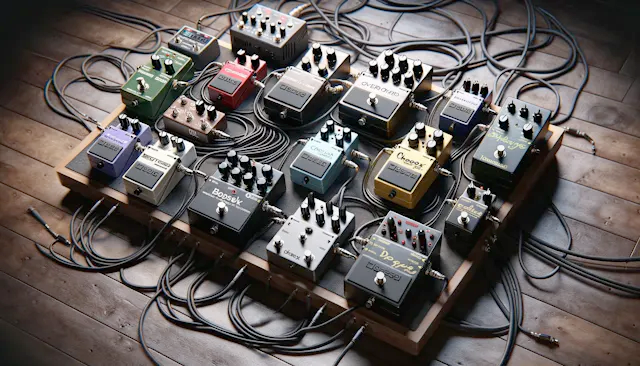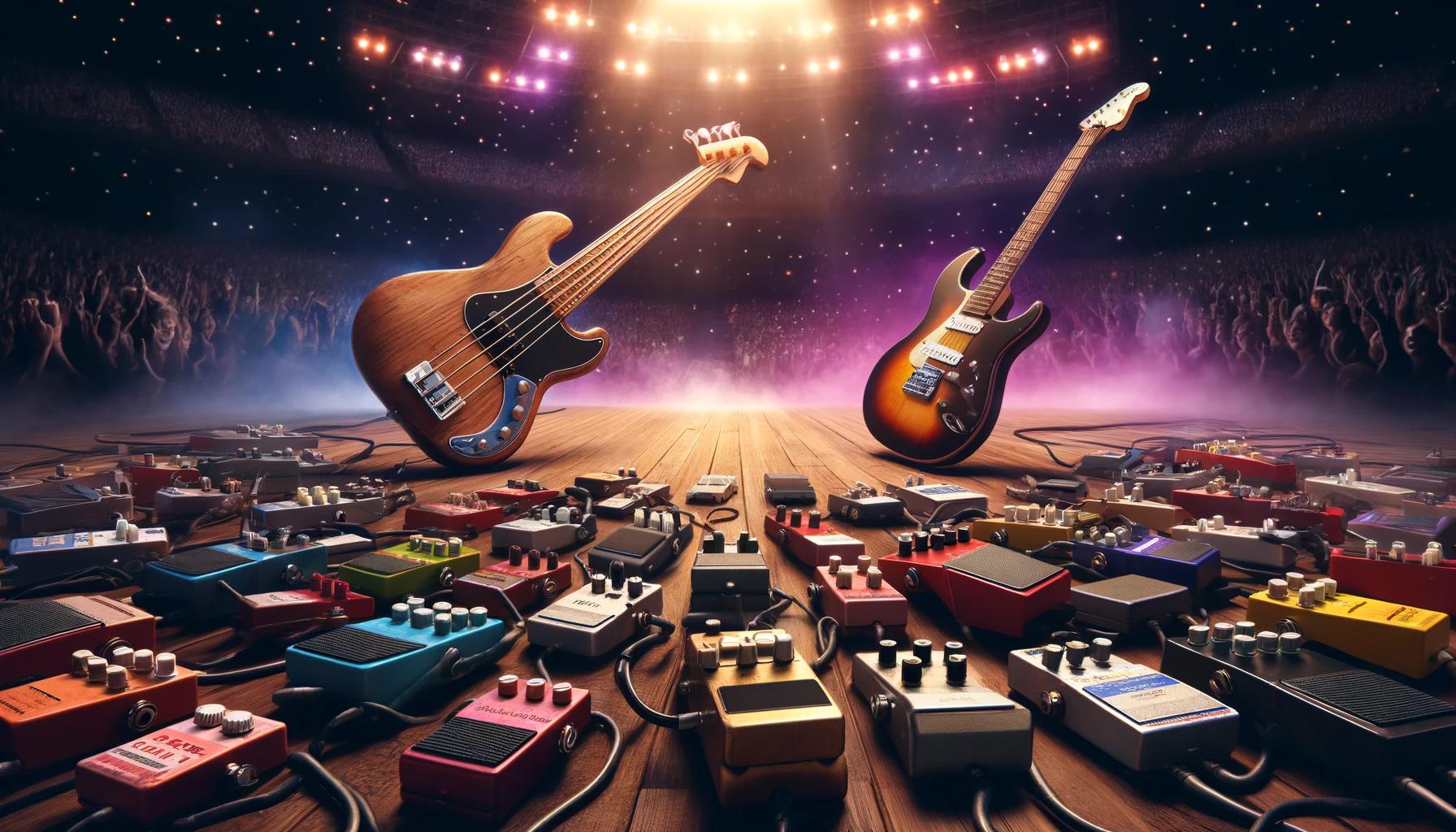
 Anthony Easton
Anthony Easton
Guitar effects are essential tools that shape the sound of a guitar in various music genres. Among these, distortion and overdrive pedals are crucial for creating the signature sounds of rock, blues, and many other styles. Understanding the differences between distortion and overdrive is key for guitarists aiming to craft their unique tone.
Overdrive, the milder cousin of distortion, simulates the warm, clipped sound that an overdriven tube amp produces at high volumes. This effect gently boosts the guitar's signal, enhancing its natural qualities without drastically altering its character. Overdrive is often associated with blues and rock, where it adds a gritty, yet dynamic texture to the guitar's sound. Famous overdrive pedals include the Ibanez Tube Screamer and the Boss OD-1.
Overdrive effects are designed to replicate the tonal characteristics of vintage tube amplifiers pushed beyond their normal operating limits. When a tube amp is driven hard, it naturally compresses and clips the signal, creating a warm, rich harmonic distortion. This phenomenon was discovered by guitarists seeking more volume and presence in their live performances, leading to the birth of overdrive as an effect pedal.
The key to overdrive's appeal lies in its ability to offer guitarists control over the amount of distortion added to their signal. By adjusting the pedal's settings, players can achieve everything from a subtle, clean boost to a crunchy, near-distortion effect. This versatility makes overdrive a staple on pedalboards across genres, particularly in blues, rock, country, and jazz.
Overdrive pedals typically work by amplifying the guitar's signal to a point where soft clipping occurs. Soft clipping rounds off the signal peaks in a more gradual manner compared to the hard clipping of distortion pedals. This process preserves the fundamental tone of the guitar while adding harmonic richness and sustain.
Many overdrive pedals offer a range of controls, including gain (or drive), which adjusts the level of overdrive; tone, which shapes the color of the overdriven sound; and level (or volume), which sets the output volume of the pedal. Some models also include additional features such as EQ settings or switchable modes for different clipping characteristics.
Selecting an overdrive pedal depends on several factors, including the desired sound, the type of guitar and amplifier used, and the specific musical context. Guitarists should consider the following when choosing an overdrive pedal:

Distortion is a powerful guitar effect that enhances the sound by producing a thicker, more saturated tone through aggressive signal processing. By hard clipping the guitar's signal, distortion adds harmonic complexity, sustain, and a pronounced edge to the sound, making it a cornerstone of genres like metal, hard rock, punk, and grunge. It transforms the guitar's output into a more forceful and emotive instrument, capable of conveying a range of intense emotions. Iconic distortion pedals, such as the Pro Co RAT and the Boss DS-1, have become synonymous with the effect, each offering unique tonal characteristics that have shaped the sound of countless classic recordings.
The essence of distortion lies in its ability to radically alter the guitar's sound by introducing a high degree of signal clipping. This process not only increases the volume but also enriches the sound with additional harmonics, creating a fuller and more engaging listening experience. Originally, guitarists stumbled upon the distorted sound by driving their amplifiers harder than they were designed to handle. This quest for louder and more aggressive tones led to the development of distortion pedals, which offered a practical and controllable means to achieve similar effects without the need for excessive volume.
Distortion's appeal is its raw power and the density it brings to the guitar's tone, making it indispensable for styles that demand a bold and upfront sound. From the searing solos of heavy metal to the gritty rhythms of garage rock, distortion provides the sonic heft and energy that define these genres.
Distortion pedals achieve their characteristic sound by employing hard clipping to the guitar's signal. Unlike overdrive's soft clipping, which gently rounds off the peaks of the signal, hard clipping sharply truncates these peaks, resulting in a more intense and aggressive effect. This process significantly alters the original tone of the guitar, adding sustain and making every note stand out more distinctly in a mix.
Control-wise, distortion pedals typically feature gain (or distortion) settings to adjust the intensity of the effect, tone controls to shape the sound's color, and volume knobs to set the overall output level. Some pedals also offer additional features like multiple distortion modes, built-in EQs, or dual channels for even greater flexibility and customization.
When selecting a distortion pedal, guitarists should consider their specific needs and preferences, including:

Distortion pedals are more than just tools for increasing volume; they're the key to unlocking new textures, emotions, and dynamics in guitar playing, serving as a vital ingredient in the creation of compelling and memorable music.
Understanding the nuances between distortion and overdrive is crucial for guitarists and musicians looking to sculpt their ideal sound. At the heart of their difference lies the method and extent of signal clipping, a process that fundamentally alters the guitar's output, affecting its tone, dynamics, and overall character.
The choice between overdrive and distortion often depends on the musical context and the desired aesthetic.
While both effects alter the guitar's signal, they do so in ways that produce distinctly different tonal qualities and textures. Overdrive's effect is generally smoother and more organic, blending seamlessly with the guitar's original tone. This makes it an excellent choice for players who want to enhance their sound without drastically changing its character.
Distortion offers a more radical transformation, imbuing the guitar with a bold and aggressive character that can dramatically alter the musical landscape. The texture provided by distortion is denser and more uniform, filling the sonic space with its distinctive growl and sustain.
Ultimately, the decision between distortion and overdrive—or the choice to use both in tandem—reflects a guitarist's personal style, the demands of the music they play, and their pursuit of the perfect tone. Whether seeking the subtle enhancement of overdrive or the bold assertiveness of distortion, understanding these key differences empowers musicians to make informed choices that complement their musical expressions and bring their sonic visions to life.
In the quest for the ultimate guitar tone, musicians often turn to pedals that offer a harmonious blend of overdrive and distortion. Dual-channel pedals, featuring distinct overdrive and distortion circuits, represent a pinnacle of versatility and innovation in guitar effects technology. These multi-functional units are designed for guitarists who crave the ability to seamlessly transition between the smooth, nuanced tones of overdrive and the aggressive, saturated sounds of distortion within a single performance or song.
Dual-channel pedals with one overdrive channel and one distortion channel are more than just practical solutions for space-saving on pedalboards. They are creative tools that open up new avenues for sonic exploration, offering:

Several pedals have gained acclaim for their exceptional handling of both overdrive and distortion, becoming favorites among guitarists for their versatility and sound quality:
To fully leverage the capabilities of dual-channel overdrive/distortion pedals, guitarists should consider the following tips:
In conclusion, dual-channel pedals that combine overdrive and distortion channels offer unmatched versatility and creative potential. By carefully selecting and experimenting with these pedals, guitarists can discover new dimensions in their sound, pushing the boundaries of their musical expression.
Check out the latest news and articles from around the pedal world.

 Anthony Easton
Anthony Easton
 Anthony Easton
Anthony Easton
 Anthony Easton
Anthony Easton
 Anthony Easton
Anthony Easton
 Anthony Easton
Anthony Easton
 Anthony Easton
Anthony Easton
 Anthony Easton
Anthony Easton
 Anthony Easton
Anthony Easton
 Anthony Easton
Anthony Easton
 Anthony Easton
Anthony Easton
 Anthony Easton
Anthony Easton